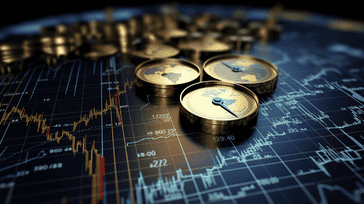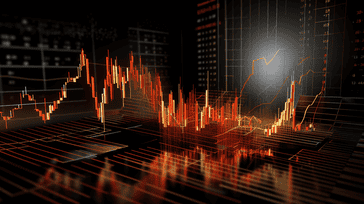Forex Market News and Events: Navigating Market Volatility



The forex market is constantly in motion. With its ever-changing landscape, staying informed about the latest news and events is crucial for success in trading. Traders must have a solid understanding of market dynamics, identify trends, and make informed decisions based on expert insights and analysis.
Market volatility is a natural part of the forex trading experience. Economic, geopolitical, and global events can all have a significant impact on currency values. Staying informed about market news and events can help traders prepare for these fluctuations and mitigate potential risks.
The forex market, also known as the foreign exchange market, is a decentralized global market where traders buy and sell currencies. It's the largest financial market in the world, with an average daily trading volume of $5 trillion.
Currency trading in the forex market is based on the exchange rate between two currencies. Traders speculate on whether the value of one currency will rise or fall against another, and profit from the difference. For example, if a trader believes the value of the US dollar will increase against the euro, they can buy US dollars and sell euros.
The forex market operates 24 hours a day, five days a week, across different time zones. It's accessible to traders from all over the world, making it a highly liquid market. However, trading in the forex market carries a high level of risk due to fluctuations in currency values.
Currency trading is influenced by a variety of factors, including economic indicators, geopolitical events, and central bank policies. Traders use a range of analysis techniques to identify trends and make informed trading decisions.
Technical analysis involves studying charts and using mathematical indicators to identify patterns and potential price movements. Fundamental analysis looks at economic data and other external factors that can affect currency values, such as inflation and political stability.
It's important for traders to understand the dynamics of currency trading and the factors that can impact currency values. This knowledge can help traders make informed decisions and manage risk effectively.

When it comes to the forex market, analysis is key. Proper analysis of the market can help traders make informed decisions and stay ahead of trends. There are two main types of analysis used to analyze the forex market: technical analysis and fundamental analysis.
Technical analysis is the study of past market data, primarily price and volume, to identify patterns and potential future market movements. Technical analysts use charts and technical indicators to identify trends and trading opportunities.
Some of the most commonly used technical indicators in forex market analysis include moving averages, relative strength index (RSI), and Fibonacci retracements. These indicators help traders identify potential support and resistance levels, trend continuations, and reversals.
Fundamental analysis is the study of economic, financial, and other qualitative and quantitative factors that affect the forex market. This analysis looks at factors such as economic releases, political developments, and natural disasters to predict potential movements in currency prices.
Some of the most commonly used fundamental indicators in forex market analysis include Gross Domestic Product (GDP), Consumer Price Index (CPI), and central bank interest rate decisions. These indicators help traders identify potential changes in monetary policy, inflation, and economic growth.
One of the most important aspects of forex market analysis is identifying trends. Forex trends are directional movements in currency prices that can last for a prolonged period. Trading with the trend is often considered a profitable strategy in forex trading.
Traders can identify forex market trends using technical analysis, fundamental analysis, and price action. Using a combination of these techniques can help traders make informed decisions about market trends and potential trading opportunities.
Overall, proper analysis of the forex market is essential for successful trading. Using both technical and fundamental analysis can help traders stay informed and ahead of market trends and movements.
The forex market is influenced by a variety of factors, both economic and political. Keeping track of these key indicators can help traders make informed decisions.
Economic indicators, such as gross domestic product (GDP), inflation, and employment figures, are closely monitored by forex traders. Positive economic data can lead to an increase in the value of a country's currency, whereas negative data can cause a drop in value.
It's essential to keep an eye on economic calendars to stay updated on upcoming releases and their potential impact on currency pairs. Interpreting economic data correctly can be challenging, so it's crucial to have a solid understanding of the underlying economic principles.
Central banks make decisions about interest rates, which affect the value of their respective currencies. In general, a higher interest rate can boost a currency's value as it attracts foreign investment. Conversely, a lower interest rate can cause a currency to depreciate.
Traders keep a close watch on interest rate announcements, such as those made by the Federal Reserve in the United States or the European Central Bank. Interest rate decisions can have a significant impact on currency movements, so it's essential to stay updated on any changes.
Geopolitical events, such as political upheaval, natural disasters, and global pandemics, can cause significant volatility in the forex market. These events can affect a country's economic stability, leading to changes in currency values.
Traders need to stay informed about major geopolitical developments and their potential impact on the forex market. While it's impossible to predict the future with certainty, understanding the potential risks and opportunities can inform trading decisions.
Central banks play a crucial role in the forex market, not only through interest rate decisions but also through other monetary policies such as quantitative easing. These actions can affect the value of a country's currency.
Traders pay close attention to central bank statements and speeches, as they can provide valuable insight into future monetary policy decisions. Understanding how central bank actions can affect the forex market is essential for successful trading.

Traders in the forex market employ various strategies to capitalize on market movements. These strategies differ in their approach, duration of trades, and level of risk. It's important to find a strategy that aligns with your trading style and risk tolerance. Here are some common forex market strategies:
Regardless of the strategy you choose, risk management is essential. This includes setting stop-loss orders to limit potential losses and avoiding over-leverage.
"The most important thing in trading is not to lose money. The second most important thing is not to lose money. The third most important thing is not to lose money. The fourth most important thing is to make a profit." - George Soros
George Soros' quote highlights the importance of prioritizing risk management over potential profits. A solid trading plan that includes risk management is the foundation for any successful forex trading strategy.
Staying up-to-date with the latest forex market news and updates is crucial for informed trading decisions. Here are some effective ways to keep track of the news:
By utilizing these tools, traders can stay informed and react quickly to changes in the forex market. However, it's important to be cautious and verify information from multiple sources before making any trading decisions based on the news.

Major events can significantly impact the forex market and should be monitored by traders. These events can range from economic releases to global events and everything in between.
Economic releases include various reports, such as Gross Domestic Product (GDP) and Consumer Price Index (CPI), that provide insight into a country's economic health. These reports can impact the forex market as they give investors an idea of the economic conditions in a country. For example, a higher than expected GDP can strengthen a country's currency, while lower than expected CPI can weaken it.
The decisions made by central banks, such as interest rate changes and monetary policy shifts, can have a significant impact on the forex market. The announcements made by central banks can provide insight into the future economic conditions of a country and can influence forex traders' decisions.
Political developments, such as elections and changes in government leadership, can create uncertainty and volatility in the forex market. For example, a new government may implement policies that can impact a country's economy and currency. Traders need to be aware of such changes and adjust their trading strategies accordingly.
Global events, such as natural disasters and geopolitical tensions, can also impact the forex market. These events can cause uncertainty and volatility in the market, leading to currency fluctuations. Traders need to consider global events and their potential impact when making trading decisions.
When it comes to the forex market, analyzing trends is crucial for making informed trading decisions. There are several factors that can influence forex market trends, such as economic data releases, central bank policies, and geopolitical events.
Technical analysis and fundamental analysis are two common approaches used to analyze the forex market. Technical analysis involves examining charts and using indicators to identify patterns and trend direction. Fundamental analysis, on the other hand, involves analyzing economic and political data to determine the underlying strength or weakness of a currency.
One key tool used in forex market analysis is the economic calendar, which provides a schedule of upcoming economic releases and events that are likely to impact the market. Traders can use this information to plan their trades and stay ahead of potential market-moving events.
Technical analysis is a popular method used to analyze forex market trends. It involves examining historical price charts and using indicators to identify potential buy and sell signals. Some commonly used technical indicators include moving averages, relative strength index (RSI), and Bollinger Bands.
Traders can use technical analysis to identify trends and potential entry and exit points for trades. For example, if a currency pair is trading above its 200-day moving average, it is generally considered to be in an uptrend, and traders may look for buying opportunities.
Fundamental analysis involves examining economic and political factors to determine the strength or weakness of a currency. For example, a country with a strong economy and stable political environment is likely to have a stronger currency compared to a country with a weaker economy and political instability.
Traders can use fundamental analysis to identify potential trading opportunities, such as by analyzing interest rate differentials between two currencies or by monitoring central bank policies and statements.
Many traders use a combination of technical and fundamental analysis to analyze the forex market and identify potential trading opportunities. By using both approaches, traders can gain a more comprehensive understanding of the market and make more informed trading decisions.
Staying current with forex market trends is essential for successful trading. Traders can use a variety of resources to stay informed, such as financial news websites, social media, and forex market analysis reports.
It is also important to continuously adapt to changing market conditions and adjust trading strategies accordingly. By staying informed and flexible, traders can increase their chances of success in the forex market.
In conclusion, forex trading can be a lucrative endeavor for those who are equipped with the necessary knowledge and skills. Staying informed about market news and events is crucial for making informed trading decisions. A thorough understanding of the forex market and analysis techniques, such as technical and fundamental analysis, can aid in identifying trends and potential trading opportunities.
Developing effective trading strategies and risk management techniques is essential for long-term success in forex trading. Traders should continuously adapt and evolve their strategies to keep up with changing market conditions.
Continuous learning and improvement are also key factors in successful forex trading. As the market evolves, traders should actively seek out new information and resources to improve their trading skills.
Overall, forex trading requires diligence, discipline, and a commitment to continuous improvement. By staying informed, analyzing market trends, and developing effective trading strategies, traders can successfully navigate the forex market and achieve their financial goals.
Staying updated with forex market news and events is important because it helps traders navigate market volatility and make informed trading decisions. By staying informed about the latest developments, trends, and expert insights, traders can identify potential opportunities and manage risks effectively.
The forex market, also known as the foreign exchange market, is where currencies are traded. It is a global decentralized market where participants buy, sell, and exchange different currencies based on their values. It is the largest financial market in the world, with trillions of dollars traded daily.
There are various techniques and tools used to analyze the forex market. Popular methods include technical analysis, which involves studying price charts and patterns, and fundamental analysis, which involves analyzing economic factors and news events. By combining these approaches, traders can gain insights into market trends and potential trading opportunities.
Key indicators in the forex market are factors that provide insights into the market's health and direction. These indicators may include economic data like GDP, interest rates, inflation rates, geopolitical events, and actions taken by central banks. Understanding and monitoring these indicators can help traders anticipate market movements and adjust their trading strategies accordingly.
There are various strategies used in forex market trading. Some popular ones include scalping, which involves making quick trades to capture small profits, day trading, which involves opening and closing positions within the same day, swing trading, which involves holding positions for a few days to a few weeks, and position trading, which involves holding positions for longer durations. Additionally, effective risk management and having a well-defined trading plan are crucial for successful trading.
To stay updated with forex market news, you can subscribe to reliable news sources that provide real-time updates and analysis. Following influential traders and analysts on social media platforms can also provide valuable insights. Additionally, utilizing economic calendars and setting up news alerts can help you stay informed about key events that may impact the forex market.
Various events can significantly impact the forex market. These include economic releases such as GDP reports, employment data, and central bank announcements. Political developments, such as elections or policy changes, can also have a significant impact. Furthermore, global events like natural disasters or geopolitical tensions can affect currency movements. Understanding how these events can influence the forex market is vital for successful trading.
Analyzing trends in the forex market involves studying historical price data, identifying patterns, and monitoring market behavior. Traders use technical analysis tools, such as trendlines, moving averages, and chart patterns, to identify trends and potential trading opportunities. It is essential to continuously analyze and adapt to changing market conditions to stay ahead in the forex market.